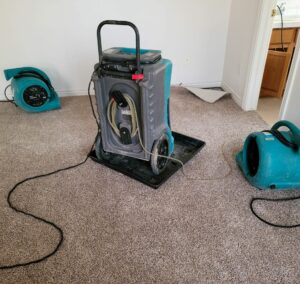Restoring a home after water damage involves various critical steps, with dehumidification standing out as one of the most important. Excessive moisture not only undermines the structural integrity of your property but also creates an ideal breeding ground for mold and mildew, which can pose serious health risks. The role of dehumidifiers in the house restoration process cannot be overstated. These devices work tirelessly to extract moisture from the air, ensuring that your home remains dry, comfortable, and safe.
In this blog, we delve into the significance of dehumidification in house restoration, explore how dehumidifiers work, guide you on choosing the right dehumidifier, and offer tips on the proper placement and maintenance of these essential devices. Whether you’re dealing with the aftermath of a flood or simply battling high humidity levels, understanding the pivotal role of dehumidification is the first step towards reclaiming your healthy living space.
Importance of Dehumidification in House Restoration
Dehumidification plays a vital role in the house restoration process, especially when it comes to combating excessive moisture. High humidity levels can lead to a host of problems, such as mold growth, musty odors, and damage to furniture and structural components. By effectively reducing moisture levels, dehumidifiers help prevent these issues and create a healthier living environment.
One of the key benefits of dehumidification is the prevention of mold growth. Mold thrives in humid environments and can cause significant health problems, including respiratory issues and allergies. By maintaining optimal humidity levels, dehumidifiers help inhibit the growth of mold and keep your home safe and mold-free.
Additionally, dehumidifiers also help preserve the integrity of your home’s structure and belongings by preventing moisture-related damage. Wood rot, peeling paint, and warped furniture are just a few of the problems that can arise from prolonged exposure to excessive moisture. Dehumidifiers, with their ability to extract moisture from the air, play a crucial role in protecting your home and belongings from these potential risks.
How Dehumidifiers Work
Dehumidifiers are essential appliances in reducing moisture levels and ensuring a healthier living environment. Understanding their basic functioning can help homeowners make informed decisions on selecting and utilizing them effectively. The primary mechanism of a dehumidifier involves pulling in moist air and passing it over a cooling coil. This process causes the moisture in the air to condense into water droplets, which are then collected in a reservoir or drained away.
The dehumidifier then releases the drier air back into the room, effectively reducing humidity levels. By removing excess moisture from the air, dehumidifiers play a crucial role in preventing mold growth, reducing allergens such as dust mites, and minimizing musty odors. They also help safeguard furniture, carpets, and other belongings from damage caused by excessive moisture. Whether it’s due to high humidity levels or water damage, dehumidifiers are an essential tool for maintaining a healthy and comfortable living space.
Choosing the Right Dehumidifier
When it comes to selecting a dehumidifier for your house restoration project, there are several factors to consider that can significantly impact its effectiveness. Firstly, you need to assess the size of the area that requires dehumidification. Dehumidifiers come in different sizes, measured by their moisture removal capacity in pints per day. Choosing one with the appropriate capacity for your space ensures optimal moisture reduction.
Secondly, you should evaluate the humidity levels in your home. Some dehumidifiers have built-in humidity sensors that can detect and maintain a set humidity level automatically, while others require manual adjustments. Understanding the humidity levels in your space and how you want to control them will help you determine which type of dehumidifier is best suited for your needs.
Lastly, consider the noise level of the dehumidifier. If the restoration project involves areas where you or others will spend significant time, such as bedrooms or living rooms, you might want to opt for a quieter model. On the other hand, if the dehumidifier is placed in a basement or utility room, noise might not be as much of a concern. By keeping these factors in mind, you can ensure that you select the right dehumidifier for your house restoration project. Finding a balance between capacity, humidity control, and noise levels will ultimately help you achieve the desired outcome in creating a healthier living environment.
Placement and Maintenance of Dehumidifiers
Dehumidifiers play a crucial role in maintaining an optimal living environment by reducing excess moisture levels in your home. To enhance their effectiveness, it is important to position and maintain these devices correctly. When it comes to placement, the key is to identify the areas in your home that are most prone to moisture buildup. Common trouble spots include basements, laundry rooms, bathrooms, and kitchens. It is recommended to place the dehumidifier in a central location within these areas to ensure maximum coverage. Additionally, keep the device away from walls and furniture to allow proper air circulation and avoid any potential blockage.
Maintenance is equally important to ensure the longevity and efficiency of your dehumidifier. Regularly clean the air filters to remove dust and debris that can hinder performance. Check the water collection tank frequently and empty it as needed to prevent overflowing. Furthermore, inspect the drainage hoses periodically to ensure they are properly connected and free from any blockages. By following these best practices for positioning and maintaining your dehumidifiers, you can significantly enhance their effectiveness in reducing excess moisture levels in your home. Remember, proper placement and regular maintenance are key to ensuring a healthy and comfortable living environment for you and your family.

We Will Help Dehumidify Your Home
When it comes to managing excessive moisture and restoring your home to its optimal condition, collaboration with professionals can be crucial. As you have learned in this blog, dehumidifiers are a key tool in your water damage restoration arsenal. However, finding the right dehumidifier and getting it properly set up can be intimidating. Luckily, you can seek expert guidance from professionals, such as the ones on our team at ASAP Restoration. If you are in the process of restoring your property after water damage, contact us for our insight and expertise today.

